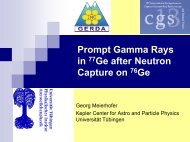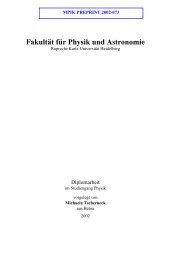Master Thesis
Master Thesis
Master Thesis
Create successful ePaper yourself
Turn your PDF publications into a flip-book with our unique Google optimized e-Paper software.
Figure8.4: Luminosityfunction ofgalaxiesΦ<br />
Φ is defined as number of galaxies given in the specific volume h 3 M pc −3 , whose luminosity ranges in a magnitude<br />
difference∆M= 1 and is therefore proportional to dn/d log M. According to the text, magnitudes of<br />
M=−22 corresponds to objects with masses of m=10 12 M ⊙ with a scale of r≈ 3.4M pc and M=−7 corresponds<br />
to m=10 6 M ⊙ and r≈ 34kpc. The plotted data is taken from [47], [48], [49]. A strong deviation of the<br />
expecteddashedlineoccursatabout M B=−12,correspondingtoλ=100kpc, k=90h M pc −1 or l= 4.51·10 5 .<br />
to be no evidence that there exist such a huge amount of ’small’ only gravitationally acting objects. Thus one has to<br />
conclude that the primordial ’seed fluctuations’, from which such dark matter haloes originate never existed.<br />
What kind of conclusions can now be drawn from this observation for the Planck scale physics? The general idea of<br />
inflation physics is, that fluctuations are produced before and at horizon crossing. This means (see figure 8.6), that<br />
usually a small scale fluctuation is growing due to the strong Hubble expansion of H= 6·10 −6 m pl (see section 4.8.1)<br />
and is affected by fluctuations. At horizon crossing the fluctuations freeze out and remain untouched until the scale<br />
reaches the Hubble horizon again. Then the perturbations evolve according to cosmological perturbation theory, as it is<br />
implemented incmbeasy. One might describe the generation of fluctuations of∆ R(k) by using a rather phenomenological<br />
approach:<br />
∆ R(l)=<br />
� lhor+ε<br />
l P<br />
F(a, l)d ln l , (8.6)<br />
where the function F(a, l)≥ 0 is a fluctuation generation function, which is a function of the length scale l. To parameterize<br />
the ’time’, at which the fluctuation generation happens, F is also a function of the comoving scale k. The interpretation<br />
of the integral is that a comoving scale k begins to grow from the Planck scale l P to the horizon scale l hor and a bit beyond.<br />
During this growth the comoving scale collects fluctuation contributions on every extension, then freezes at the<br />
horizon and remains unchanged until it enters the horizon again. The question comes up, what the properties of F(a, l)<br />
are? The above consideration tells, that F(a, l)=0,∀λ
















